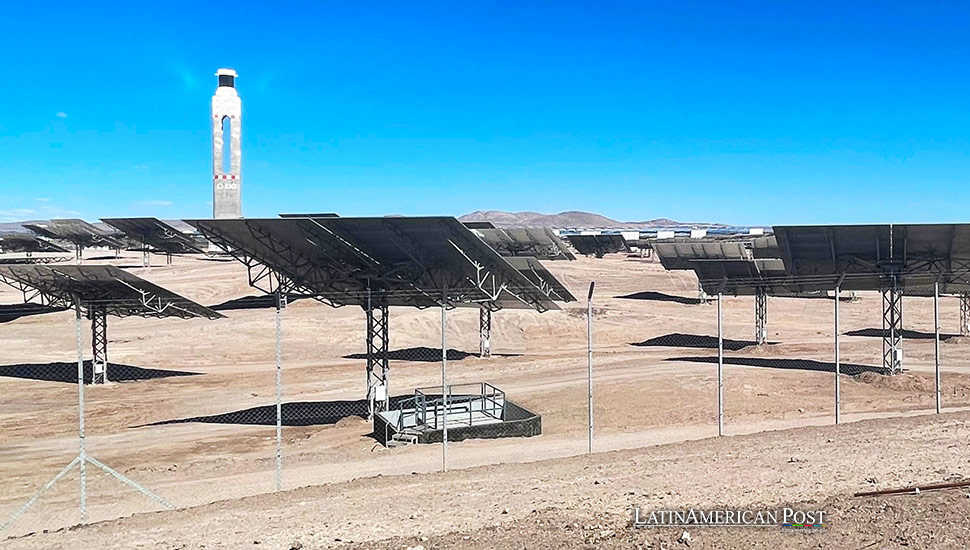Chilean Cerro Dominador’s Thermosolar Plant Faces Setbacks

The Cerro Dominador thermosolar plant in Chile’s Atacama Desert, a pioneer in Latin America, has been halted for over a year due to a malfunctioning molten salt storage system. This has slowed the expectations of this emblematic clean energy project.
Over a year ago, the pioneering Cerro Dominador thermosolar plant, nestled in the heart of Chile’s Atacama Desert, faced a setback. The malfunctioning of its molten salt storage system, a key component of its innovative design, halted its operations. This plant, a beacon of hope in Latin America’s clean energy sector, now confronts significant challenges.
The issue arose sooner than anticipated. “These are things that happen with such projects, but we didn’t expect it to happen this quickly,” explains Pablo Cavallaro, Legal Affairs Director at Cerro Dominador, during a recent press visit.
The Technology Behind Cerro Dominador
The Cerro Dominador thermosolar plant is a unique combination of two cutting-edge technologies: a 100 MW photovoltaic (PV) system, which operates only when the sun shines, and a 110 MW Concentrated Solar Power (CSP) system, the first of its kind in Latin America. The CSP system, with its 17.5 hours of molten salt storage, sets it apart, allowing it to generate clean energy around the clock.
Located 60 kilometers from Calama, in one of the sunniest spots on Earth, Cerro Dominador harnesses solar power through 10,600 massive mirrors (heliostats), each covering 140 square meters. These mirrors follow the sun and direct its rays to a receiver atop a 250-meter tower. The concentrated solar energy heats the molten salts to temperatures exceeding 560 degrees Celsius and is stored in large tanks. The stored heat generates electricity via a steam turbine, providing power day and night to approximately 380,000 homes.
However, this ambitious system has faced setbacks. “The hot salt tanks began showing problems in the walls and floors,” Cavallaro noted, pointing out issues in design and construction due to inadequate heat resistance.
Impact on Local Economy and Tourism
The halt in operations at Cerro Dominador has not only affected energy production but also had a ripple effect on the local economy and tourism. Samuel Muñoz, a lifelong resident of Calama, recalls the plant’s inauguration as a significant event for a region often neglected by the state. “It was essential for this area. While it’s not a major tourist destination, it attracted those interested in clean energy. Now, they don’t come anymore,” he lamented.
César Diestro, responsible for quality at Cerro Dominador and an employee for six years, witnessed the plant operating at total capacity from its inauguration in June 2021 by the late President Sebastián Piñera until May 2022, when the tanks failed. “One of the most complicated and delicate systems is the salt storage. The materials used for pipes and tanks are methodologically complex, requiring strict welding procedures and extensive analysis,” Diestro explained.
With no precise date for resuming operations and repairs costing several million dollars, the thermosolar plant is currently undergoing preservation tasks to prevent system deterioration. Meanwhile, the photovoltaic plant continues to supply energy to Chile’s Central Interconnected System (SIC), which serves the entire country.
Despite the setbacks, experts remain bullish on the potential of thermosolar technology. Frank Dinter, a researcher at the Solar Energy Research Center at the University of Chile, underscores Cerro Dominador’s role in validating the technical and economic feasibility of CSP in Chile. He points out that CSP’s primary advantage over other non-conventional renewables is its capacity to generate base power and be dispatchable, thanks to thermal storage systems that store daytime energy for use when needed, aligning with demand curves.
The project, which required a $1.4 billion investment, is now under the control of the Canadian fund Brookfield, with participation from EIG Global Energy Partners. The repair work, a crucial step in restoring the plant’s operations, is being carried out by the Spanish company Acciona, a testament to the international collaboration in the renewable energy sector.
Cavallaro remains optimistic about the future of this technology. “We still believe in it wholeheartedly,” he emphasized. He concluded by stating that all the lessons learned from this experience will ensure that such issues do not recur.
The Road Ahead for Clean Energy in Latin America
Cerro Dominador’s journey reflects the broader challenges and opportunities in Latin America’s renewable energy sector. The region, rich in natural resources like solar and wind, has the potential to become a global leader in clean energy. However, realizing this potential requires overcoming technical, financial, and regulatory hurdles.
In Latin America, projects like Cerro Dominador play a crucial role in proving the viability of advanced renewable technologies. These projects not only attract further investments but also drive the region’s transition to sustainable energy. Chile, in particular, has emerged as a pioneer in this field, with ambitious targets for renewable energy integration.
The issues faced by Cerro Dominador also highlight the need for robust infrastructure and skilled labor to support the growing renewable energy sector. Training programs and partnerships with international firms can help build local capacity, ensuring that projects are executed efficiently and maintained properly.
Furthermore, the successful resolution of Cerro Dominador’s challenges could set a precedent for other countries in the region. By sharing knowledge and experiences, Latin American nations can collectively advance their clean energy agendas, benefiting from each other’s successes and learning from setbacks.
Also read: Chiloé’s Cultural and Natural Riches Drive Rural Tourism Boom in Chile
While the current situation at Cerro Dominador presents significant challenges, it also offers valuable lessons for the future. The resilience and commitment of the teams involved, combined with the ongoing advancements in technology and infrastructure, promise a bright future for renewable energy in Latin America. With continued support and investment, projects like Cerro Dominador can pave the way for a sustainable and prosperous energy landscape in the region.





